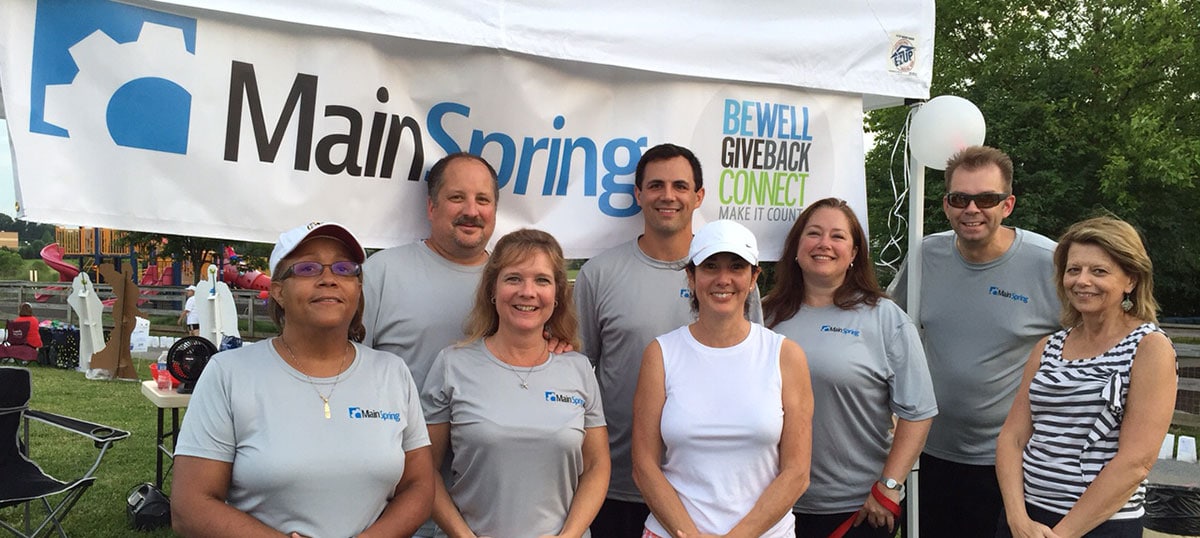
After 22 years in business, it’s tough to break old habits. But when we changed to MainSpring in February, we took the opportunity to reevaluate our community outreach efforts.
We went with a different approach and thought we’d share our lessons learned in case you’re looking to start anew or want to rejuvenate your employee engagement program.
1. Research to get it right and to get buy in
With a committee of six employees across three states, our new Make it Count program started off by doing some simple research. We wanted to make sure the causes we chose to support this year meant something to those participating. A recurring theme throughout—we kept it simple.
We used Survey Monkey (free) and distributed a three-question survey asking employees the types and specific causes they’d rally behind. These were our questions:
- What community events, charities or causes would you like to see benefit with both volunteer hours and monetary donations?
- What would motivate you to partake in more community/volunteer programs?
- What would motivate you to participate in wellness challenges?
In the past we chose local causes that were close to our company headquarters such as volunteering our time at the WUMCO Food Center, Poolesville Day (shredding) and adopting a local family at holiday time to name a few. Now that we have more than 60 employees spread across seven states, including some that travel overseas frequently, we needed to keep geography in mind. The result was that 45 percent of the employees were interested in causes related to cancer research and recovery. We found our cause.
Many employees did specify a certain cancer, but to make it easier we chose the American Cancer Society so all cancers would benefit. We provided employees in other states links to Relay for Life events in their area. Word to the wise, plan it early next year. We missed the boat on a few Relay for Life events because of our late start.
Our employee participation hit the mark, with 22 percent of staff directly contributing $785 and collectively donating well over 75 hours to the cause. Employees didn’t just dig into their own pockets, they motivated family and friends to raise an extra $1,286.75. We also upped the ante on our firm’s employee matching program, matching up to $50 for each employee which contributed to another $510.
We also mailed a personal letter from our President, who shared her story last month, inviting our clients, partners and community members to join us for the event. Some of our long-time customers, like Potomac Valley Surveys, stepped up and contributed generously.
2. Keep it simple and give people options
The American Cancer Society made it all so easy. Their website is user-friendly and super simple. The tools they provided were clear and precise. The Relay for Life website offered up fundraising ideas, sample emails and an app for iPhone and Android to track your progress, send emails and update your page.
Don’t under estimate the simplicity factor in all of this. Give people options. We used email and Facebook to rally the troops and created the team site that was ready to go prior to sending out our message. Employees could donate time, money or simply spread the word with a touch of a button.
3. Find the right communication vehicle
Social media really works. Over a third of the funds raised were through Facebook, Twitter and LinkedIn. With social platforms changing algorithms daily, the channels are becoming a pay-to-play for businesses and non-profits.
That means posting an event or message on our company’s Facebook page isn’t enough. Facebook wants companies to pay to make sure messages are delivered to followers. Instead of paying to sponsor the post, you’ll need your employees to share it.
For example, we posted our fundraising effort on Facebook three times over three weeks. Two times the post only reached 30-something people. But when our employees shared it, the message reached nearly 700 people and an engagement rate of 7 percent, two points higher than our goal for Facebook posts. In other words, people hold the power, not the brands.
4. Let good ideas bubble to the top
We learned a lot at our first company-wide charitable event. For many it was our first Relay for Life and we didn’t know what to expect.
One of our employees suggested we sell glow-in-the-dark necklaces, bracelets and batons to raise money at the event, which went until midnight. The batons were a HUGE hit. We learned that many teams sold baked goods and candy; there was plenty of sweets to go around.
We took advantage of the heat wave and sold a lot of Flavor Ice pops to all ages, and there were opportunities to do the same with cooling towels and snow cones. Another team sold necklaces for $5 and every time you completed a lap, participants received a bead to add to their necklace. Evidence that gamification/competition works.
A portion of the event also had survivors share their story. This was powerful and reminded us again why we were all there.
5. Keep it real
This was a fun event. Employees across the country got involved because it was simple, fun and hit home for many. It also got competitive. Family members and friends joined in the event. Kids were instrumental in keeping it light and learned about the importance of giving back.
It can be a grind to pull together a charitable cause, but in the end don’t lose sight of reality. Some people simply don’t have time, so set realistic goals, and keep it real.
